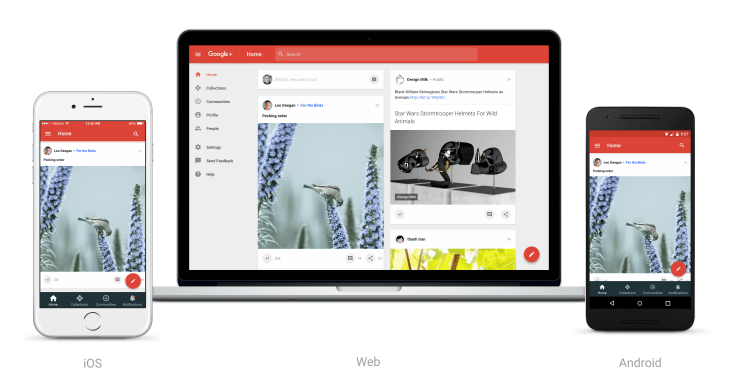Google+ has always been a project for Google, regardless of what you’ve read in the media. With projects, come changes…and there have been quite a few for Google+ this year.
The Photos product that got pulled out of G+ is doing pretty damn well, and YouTubers were happy when the service was unbundled from the video-sharing site. The shift continues today with a complete redesign, focusing on the parts of the service that are working well.
I sat down with Bradley Horowitz, VP, Photos and Streams at Google and Product Director at Google, Luke Wroblewski. The two worked together for a spell at Yahoo some eight years ago and Wroblewski is at Google by way of selling off his service Polar.
The two, along with the rest of the team have been watching how people have been using Google+ and have found that the two experiences that stand out are Communities and Collections. The new design and experience is opt-in at first, and is rolling out today.
Learnings
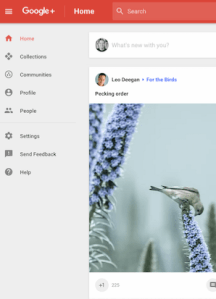 Along with Photos and backing up on YouTube, the “About Me” page that Google introduced last week are all signs that the company has learned what worked, what didn’t and are willing to move forward with said learnings. There’s no complete scrapping of anything here, which many have assumed would happen. Those people don’t understand how Google operates.
Along with Photos and backing up on YouTube, the “About Me” page that Google introduced last week are all signs that the company has learned what worked, what didn’t and are willing to move forward with said learnings. There’s no complete scrapping of anything here, which many have assumed would happen. Those people don’t understand how Google operates.
Horowitz told me: “Photos wasn’t the only product with opportunity. We asked ourselves “how can we make this better and serve more people?” We brought Luke in and he spent a lot of time architecting how we’re going to move forward with G+, looking at data, doing a ton of user research, and thinking through what are the things about this product that shine and what parts should be deemphasized.
The team also did a “road trip” where they talked to avid G+ users, asking them what they’d like to get out of using it. The new design has also been tested with hardcore users, giving Google more details to work off of.
The New G+
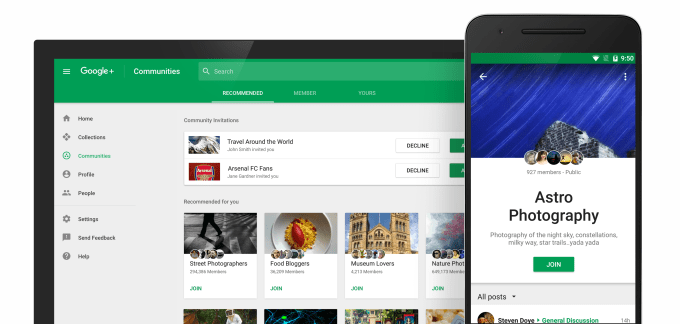
“Where it shines today, it’s actually pretty amazing. Topics like astrophotography, British dragonflies, crochet, Disc Golf Pro Ttips, Earthquakes. The topics of conversation span from niche to broad.” Wroblewski tells me. Communities were first introduced in 2012 in hopes to cancel out the need for discussion groups…including Google’s own Groups product. It succeeded. Collections are a bit newer, having been introduced earlier this year. It has also been successful and dovetailed with the Communities product nicely.
The two tell me that there are 1.2 million joins of communities a day on the platform…and collections are seeing even more pickup.
Wroblewski, known for his responsive and progressive design work, tells me that the key to this rollout is the consistent, mobile first experience that hasn’t historically been a hallmark of G+. Along with the responsive web redesign, the iOS app has been completely rebuilt and redesigned and the Android app is refocused on what people are using, pushing aside the parts that didn’t catch on.
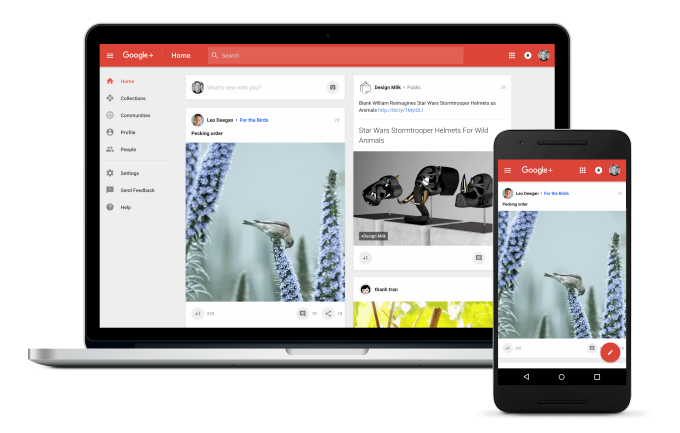
What the two showed me appears to be a more stylized version of say…Reddit or Facebook Groups. Not a bad thing, but it’s definitely relying on the userbase to fill it up with interesting things based on their interests. Wroblewski tells me that your Home feed will now be filled up with things that Google thinks you’ll be into based on all of the things they know about you and the content you’ve shared on the platform.
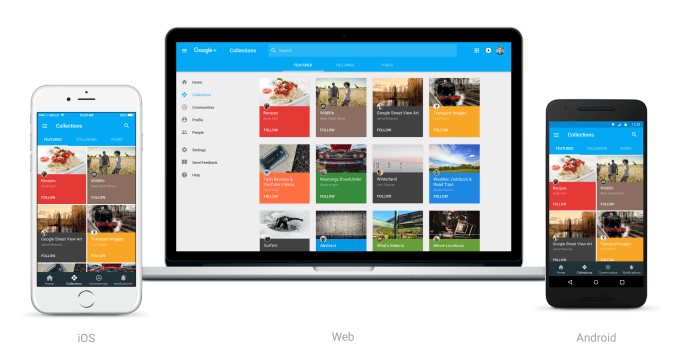
Back To Basics
 Horowitz told me that Google’s focus on product excellence under Sundar Pichai lends itself to peeling things out of Google+ for the aim of success. Hangouts and Photos are just an example, and Pichai has been a huge supporter of both products. “They’re successful because we reached in and saw what’s working.” Horowitz explained. “We’re building to how people are using.” Wroblewski shared.
Horowitz told me that Google’s focus on product excellence under Sundar Pichai lends itself to peeling things out of Google+ for the aim of success. Hangouts and Photos are just an example, and Pichai has been a huge supporter of both products. “They’re successful because we reached in and saw what’s working.” Horowitz explained. “We’re building to how people are using.” Wroblewski shared.
As you click through the new Google+ there is a lighter feel to it for sure. It’s a product with more purpose, as before it felt like there was a million things flying at you. Notifications, +1’s, share buttons. You were pretty much sharing things into a pit and hoping that Google would do fun things with them. Even the number of animations, then called “Auto-awesome”, were a bit out of control Horowitz told me. Mind you, they haven’t gone away, as they now have a place in the Photos product that makes sense contextually and don’t happen as often. Basically, it worked…but not where it was or how it was implemented.
In a sense, Wroblewski and team were tasked with knocking down the game of Jenga Google+ was playing and then put it back together in a way that won’t topple over. Or, as Horowtiz calls it: “Reinvention with frameworks.”
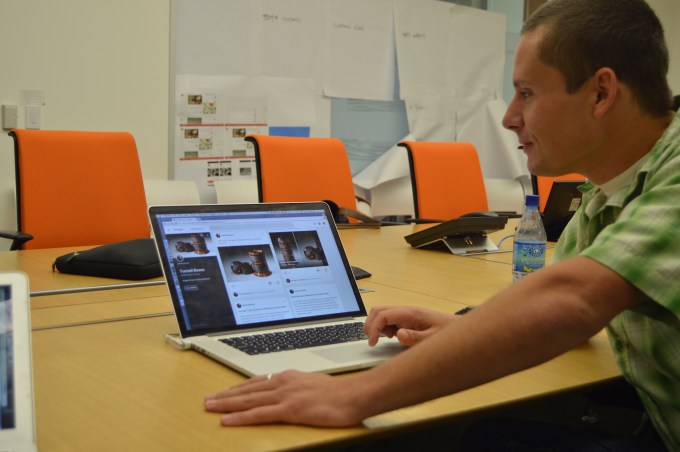
Continuing to click through, you’ll find some Communities that baffle you. Turned Boxes. What the hell are those? It has 27,202 followers. Some of them are pretty straight forward and have a pretty impressive following. For example, a community about Apple has over 400,000 members and over 40,000 posts in it. Creating a better place for those conversations to happen rather than throw the baby out with the bathwater was the right move for Google to make…because there is a sizable community that enjoys using Google+.
But it simply couldn’t last as a place-for-everything.
“We ripped it down and built it back up.” Horowitz told me plainly of Google+.
Moving Forward
As Google+ continues to evolve…albeit a bit slower and with more purpose, you’ll probably see some things introduced that worked with previous social products at the company: Buzz, Orkut, Wave, etc. That’s how Google works.
Horowitz explained: “This moment is perfect because we have the opportunity to take great technologies, unencumbered by expectations, and present them to users in a way that matters to them. It’s a way for passionate product people like Sundar, Luke and me to help people rather than hose them down with technology.”
So while Google+ was never meant to be a social network, it did turn into a place where the company liked to show off its toys. Each, like features of Google Photos, will live on, some will be dialed back. But all together? It just didn’t work out. Even companies like Facebook have figured that out. Unbundling and optimizing experiences is where it’s at.
